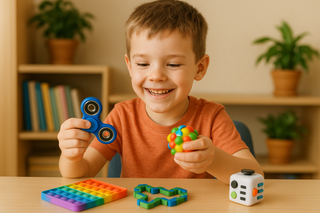Helping children with ADHD stay focused in a busy classroom can be challenging. While traditional strategies like seating arrangements and scheduled breaks help, classroom-friendly fidgets can make a significant difference. Fidgets are small, quiet toys or objects with sensory appeal that allow kids to channel excess energy without disrupting the class.
Research shows that giving a child a controlled way to fidget can improve attention, retention, and overall classroom engagement. Here are seven great fidgets that parents and teachers can incorporate to support children with ADHD.
1. Stress Balls
Stress balls are one of the most versatile fidget toys available. They can be squeezed, squished, or rolled between the hands to release tension and improve focus. Many are designed for durability, with sand or gel filling, making them perfect for classroom use.
Tip: Choose stress balls that are quiet and small enough to fit in a desk or backpack.
2. Fidget Spinners and Cubes
Fidget spinners and cubes offer multiple ways to fidget discreetly. They provide tactile engagement through buttons, switches, and rotating elements. Fidget cubes, in particular, are excellent because each side has a different activity - click, roll, glide, or flip - giving a child options to match their energy level.
3. Putty and Kneadable Clay
Kneadable putty is soft, malleable, and endlessly reusable. It can help kids build fine motor skills while giving their hands something to do during lessons. Some putties even come with textures or scents for added sensory engagement.
Bonus: Putty is also mess-free and easy to store in a pencil case or desk drawer.

4. Rubbery Finger Springs
Small, flexible finger springs or stretchy strings provide subtle tactile stimulation. Children can manipulate them with their fingers without creating noise or drawing attention, making them ideal for quiet classroom settings.
5. Desk Bands for Foot Fidgeting
Not all fidgets involve hands. Rubber bands stretched across the legs of a chair allow children to fidget with their feet — bouncing or pushing against the bands quietly. These simple devices provide sensory input without disrupting the teacher or classmates.

6. Tactile Rings and Bracelets
Wearing tactile rings or stretchy bracelets can give kids a discreet way to fidget. These are particularly useful for older children or teens who may feel self-conscious using larger fidget toys in class.
7. Paper and Creative Doodling
Sometimes, a simple pad of paper and some markers or coloured pencils can serve as a highly effective fidget. Doodling or sketching while listening helps children maintain attention, express creativity, and retain information.
Choosing the Right Fidget for Your Child
When selecting a fidget toy:
-
Make sure it’s classroom-appropriate and quiet
-
Match it to the child’s sensory needs and energy level
-
Start with one or two options to avoid overstimulation
Many teachers recommend testing fidgets at home first to see which types help your child focus best.
Conclusion
Fidget toys are more than just a trend — they are practical tools for children with ADHD to stay engaged in class. By choosing the right toy, parents can help their children channel energy constructively, reduce stress, and improve focus throughout the school day.


